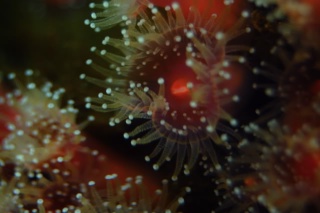TemperateAquaria Information Center
Temperate Marine Fast Facts
Temperate Marine Fast Facts
Whats the difference between temperate and tropical reefs? Temperate reefs are cheaper to keep than tropical reefs. They also require cold water (50-70˚ Fahrenheit). Since most temperate corals are found in deeper waters most aquarists often just have anemones, sponges, and macro-algae in there reef tanks. The exception being the orange cup coral. All of these invertebrates are abundant in intertidal and tidal regions of the ocean. Temperate reefs can be a fascinating and enjoyable experience for any aquarist willing to dedicate the time for them.

Anemones in Regard to Their Tropical Cousins
Temperate anemones are different from their tropical cousins in one major way: they are do not utilize zooxanthelae. This means that your standard floroucent bulb will work fine when considering what kind of lighting to use for these systems. Anemones from temperate regions require meaty foods to sustain themselves. Mysis, krill, and silversides will provide them with a good diet. Some large anemones are also fish eaters (in other words if you want your fish alive don't keep them in the same tank). There is a common assumption that temperate reefs are often dull and gray however when one can expect quite the contrary. Anemones come in brilliant pinks, reds, greens, oranges, and most are vibrantly colored. When looking to set up a colorful temperate reef one should look for these anemones.
Algae Control
Some aquarists with algae problems are generally those with high lighting. The only species that requires such lighting are marine plants (macro-algae). Upon seeing hideous amounts of algae growing on the glass, substrate, and decor of the aquarium one often wants to get rid of his lighting and plants. However the simple solution to this is acquiring one of the best known invertebrates in the marine world: the margarita snail. Margarita snails are often imported as tropical species of invertebrate. However when one goes down to investigate tide pools they are a common sight. Foraging for algae and other foods. They can be seen in large numbers grazing through these tidal and intertidal regions. Simply ordering some of these online or harvesting them from their native habitat will suffice. Collect/purchase as many as deemed necessary and you have begun building your clean up crew for your aquarium.
Lighting
When it comes to lighting the temperate reef, you can keep it simple. Since marine life in these ecosystems are non-photosynthetic due to the lack of sun expensive lighting systems selling for hundreds of dollars are not needed in this system. The only time good lighting is required is when one is keeping marine plants. Marine plants come in brilliant reds and greens and in a multitude of sizes and in order to keep them looking their best it is essential that you have good enough lighting. A simple 10K bulb will suffice for this purpose. Lights can be purchased at reasonable prices from online retailers or a local aquarium supply store.

A Note on the Picasso Triggerfish
This species of triggerfish will easily adapt to temperatures as low as 70˚ (suitable for an aquarium stocked with tidepool life). In the wild they can be found down around the south african coast. Acclimating these colorful fish to the temperature of the water is as simple as floating them in a bag. Once acclimated fully to the aquarium water they should resume their normal behavior. If signs of discomfort are noticed then the triggerfish should be immediately placed in a tropical aquarium. Keep in mind triggerfish are aggressive fish and may attack other aquarium inhabitants.
*Be sure to check local laws and regulations when collecting marine life
|
|
|








